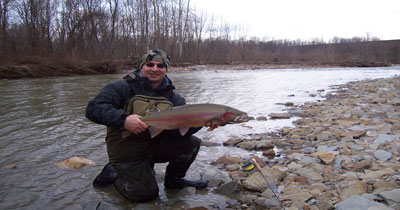Steelhead fishing can often mean fishing in cold temperatures for fish that are holding to tight to the bottom. Most of my best days of steelheading are on days that the weather is terrible from blowing snow to cold rain to wind that blows your fly line backwards. Often on these days steelhead are hugging the bottom and not willing to move to far to attack a fly.
More often than not when I'm fishing for steelhead I see to many fishermen fishing above the steelhead and not catching anything while I'm catching fish. The sole reason why so many fishermen are not catching fish is they are not using the proper weight to get down to the steelhead. When fishing for steelhead I can almost always feel my sinker bouncing along the bottom and when I don't feel the bottom I will put more weight on to get down to the bottom. Often I will have a size 5 or two size 7 split shot sinkers to get to the bottom, but will go heavier if needed. I also keep my fly anywhere from 3 to 6 feet away from my sinker which allows my fly to look nature when drifting in the current. I do loose a lot of flies to snags, but I catch a lot of steelhead. I tell everyone that I fish with if your not getting snagged your not catching fish.
Deep Rolling Steelhead Tips
- Sinkers - Always use enough weight to get to the bottom, if the water is low enough for a 3/0 split shot than use a 3/0 if it's deep change your sinkers till you get to the bottom. A size 3 or 4 split shot is not unheard of when steelhead fishing especially in fast deep water.
- Flies - Streamers, Egg Patterns & Beads under a strike indicator (bobber) By casting slightly upstream at 11:00 then mending your line you will get a perfect dead drift that will lead straight into a great swing which allows you to target a large portion of a stream.
- Line - I always use tapered leaders that I tie myself, which allows me to pinch on a split shot sinker above a blood knot, which keeps the sinker from sliding up and down the line. Try moving your split shot from 3 feet above to the fly on up the line often way up the leader. Let the steelhead tell you where they prefer the sinker. You fly will have a much different drift depending on where your sinker is located.
- The Cast - Cast upstream at 11:00 then mend your line upstream to get a good dead drift and to allow your fly to get to the bottom. Then allow your line to swing all the way to the end and leave the fly hanging in the current. Often steelhead will follow a fly around the swing and hit the fly when it hangs in the current. The strike at the end of the drift will be brutal so be prepared. Also learning to cast this much weight can be challenging for a while, but you will quickly learn how to deal with the added weight. This type of casting is often referred to as chuck n duck, all you do is pull your fly out of the water with a long powerful pull then allow your fly rod to load then chuck you fly forward. It's not pretty, but very effective for steelheading.
So the next time you're out steelheading pay attention to how well you're feeling the bottom, if you'e not feeling the bottom you're not deep enough. No snags = No Fish
